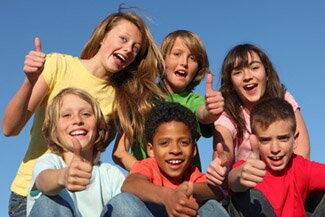Middle Childhood Development Theory Introduction

This topic center provides a review of theories of child development for children aged 8-11. For information on parenting and child development of infants aged 0 to 2, please visit our Infant Parenting and Child Development topic center. For information on parenting and child development of preschool children (early childhood aged 3 to 7, please visit our Early Childhood Parenting and Child Development topic center. For information on parenting adolescents (ages 12-24), please visit our Adolescence Child Development and Parenting and Child Development Theory: Adolescence topic center.
This document describes children's physical, mental, emotional, moral, and sexual development during the middle childhood years occurring between approximately ages 8 and 11. It is part of our Child Development and Parenting series exploring what we know about how children grow and what they need from parents in order to develop healthfully from birth through adolescence. Other d...More
Fast Facts: Learn! Fast!
What physical development takes place in middle childhood?
- During middle childhood, children's bones broaden and lengthen dramatically and in general, they will grow an average of 2-3 inches taller each year throughout this period.
- Both boys and girls are building muscle and on average, they will gain 6-7 pounds a year, each year during middle childhood.
- It's extremely important for kids of this age to continue (or to start) to lead a healthy lifestyle, including eating nutritious meals as well as getting plenty of exercise and adequate sleep every day.
- During middle childhood, children continue to build on and improve gross motor skills.
- Children in middle childhood also continue to hone their fine motor skills which can be distinguish from gross motor skills in that they require hand-eye coordination.
- Specifically, middle-childhood-aged children show dramatic improvements with regard to their printed handwriting and ability to write in cursive letters (e.g., "script" forms of handwriting).
- Children's easy use of communications tools such as cell phones and computers, which becomes possible as they master increasingly complex fine motor skills, exposes them to a world much larger and more complicated than they can possibly imagine.
What cognitive development takes place in middle childhood?
- The mental (cognitive) changes children undergo during the middle childhood era are often more pronounced and noticeable than their physical changes.
- Children's ability to consciously, thoughtfully and pro-actively choose to pursue goals (instead of simply reacting to the environment) appears during this developmental period.
- Children's thinking style gradually becomes more logical, organized, and flexible as well.
- Children in middle childhood master hierarchical classification, which is the ability to simultaneously sort things into general and more specific groups, using different types of comparisons.
- Children become able to discriminate objects that are nearby and far away based on their apparent size.
- Children become more efficient at processing "inputs," their attention span lengthens in duration and their ability to focus and concentrate their attention becomes more pronounced and reliable.
- Children's memory capacity and the ability to use their memory also increases and improves during middle childhood.
- A more visible expression of children's cognitive development during middle childhood can be found in their ability to use and appreciate increasingly sophisticated forms of language.
- In most American public schools today, IQ tests (in conjunction with achievement tests) are primarily used to determine whether a particular child needs supplemental educational programming or services above and beyond a traditional classroom.
What emotional/social development takes place in middle childhood?
- During middle childhood, children make great strides in terms of their ability to recognize emotions in themselves and others, control their own emotions, and communicate about emotions, both expressively and with language.
- As children practice interpreting people's complex emotional displays, their perspective taking abilities and their empathy skills increase.
- During middle childhood, children's personal identity develops so as to become more complex, multi-faceted and abstract in nature.
- Children's overall self-esteem may fluctuate or decrease as they start the process of social comparison with their peers.
- It's especially important that parents, teachers and other concerned adults in children's lives look out for any challenges or problems that may negatively impact the development of their overall self-image and self-esteem and do what they can to help address those problems early on so that they do not contribute to children's more permanently low self-esteem.
- During middle childhood, peer friendships take on a more prominent role than ever before.
- Children become better at reading and responding to other kids' emotions, and understanding other kids' intentions and needs; why they behave in specific ways at specific times.
- Though children's peer relationships mature and become increasingly prominent during middle childhood, children's connection to their parents and core family continues to be of tremendous importance for their well-being and functioning.
- Children's increased interest and investment in relationships with peers and adults in middle childhood makes them sensitive to the self-conscious emotions of pride, guilt and shame.
What moral development takes place in middle childhood?
- As children develop the ability to put themselves into someone else's shoes, their appreciation of morality becomes more self-directed and less black and white and absolute in nature.
- Starting at about age 10 or 11 and continuing through adolescence, children will have generally begun to view moral rules as socially-agreed upon guidelines designed to benefit the group.
- Children realize that making choices about following the rules should be based on something more than fear of negative personal consequences or desire for individual gain.
- Older children start to make moral decisions based more on how they would like others to treat them if the tables were turned, than based on what they can gain for themselves.
- By middle childhood, most children are able to stop and to think about what is the right thing to do, and to consider the potential consequences and benefits of different behaviors before they act.
- Children learn in part by modeling the behavior and attitudes of other trusted adults and older peers with whom they interact.
What gender identity and sexual development takes place in middle childhood?
- Boys' and girls' gender identities seem to develop differently during middle childhood.
- Boys tend to use more masculine traits to describe themselves, to behave in more stereotypically masculine ways, and to cultivate (but not necessarily achieve) a more concentrated and pure masculine identity free of feminine attributes.
- In contrast, many girls at this age will tend to be more androgynous in their self-descriptions, endorsing and embracing both feminine and masculine traits and behaviors.
- Children's interests, preferences, behaviors and overall self-concept are strongly influenced by parental and authority figure teachings regarding sexual stereotypes occurring in or before the early portion of middle childhood.
- For most children, the early portion of middle childhood is a time of relative sexual dormancy and disinterest.
- Starting at about the middle of the middle childhood period or later, children will begin to explore girl/boy friendships with peaked, romantic interest, and some children will develop "crushes" on peers.
- At this age, children become interested in exploring how romantic relationships differ from friendship relationships.
- Parents of school-aged children need to be alert for signs their child is acting out sexually in ways that seems inappropriate or premature.
- Age-inappropriate sexual behaviors may indicate that participating children have been sexually abused, or exposed to a peer who has been sexually abused.
News Articles
-
Clear Rules, Physical Activity Cut Children's Screen Time
In households where parents set clear and consistent limits on screen time and where children have plenty of physical activity, children have lower odds of exceeding the American Academy of Pediatrics' recommended two-hour daily screen-time limit, according to research published online June 14 in Pediatrics. More...
Resources
-
Articles
-
Introduction
- Middle Childhood Development Theory Introduction
-
Physical Development
- Physical Development: Average Growth
- Importance of Healthy Lifestyles
- Physical Development: Motor Development
-
Cognitive Development
- Cognitive Development: Piaget's Concrete Operations
- Cognitive Development: Piaget Part II
- Cognitive Development: Piaget Part III
- Vygotsky's Social Developmental Emphasis
- Attention, Memory and Meta-Cognition
- Language Development
- Intelligence: The Measurement of Cognitive Capabilities
- Causes of Intelligence
- Issues Related to IQ Testing in Middle Childhood
- IQ Scores as Predictors of Future Success
-
Emotional and Social Development
- Emotional and Social Development
- Identity and Self-Esteem
- Emotional and Social Development: Social Connections
- Moral Development: Piaget's Theory
- Kohlberg's Stages of Moral Development
- Kohlberg's Stages Continued
- Brofenbrenner's Environmentally Influenced Morality
-
Gender Identity and Sexual Development
- Gender Identity and Sexual Development
- Factors Influencing Gender Identity
- Development of Children's Sexual and Romantic Interest
- Sexual Abuse Warning Signs
-
Conclusion
- Child Development Theory: Middle Childhoood Conclusion
-
Introduction
-
News
- Clear Rules, Physical Activity Cut Children's Screen Time
-
Links
- [4] Videos
-
Videos
- Child Development: Stepping Stones - Lesson 19: The School Years: Summary
- Child Development: Stepping Stones - Lesson 16: The School Years: Biosocial Development
- Child Development: Stepping Stones - Lesson 17: The School Years: Cognitive Development
- Child Development: Stepping Stones - Lesson 18: The School Years: Psychosocial Development
Topics
-
Related Topic Centers
-
Addictions
-
Aging & Elder Care
-
Assessments & Interventions
-
Career & Workplace
-
Emotional Well-Being
-
Life Issues
-
Parenting & Child Care
-
Abuse
-
ADHD: Attention Deficit Hyperactivity Disorder
-
Adoption
-
Autism
-
Child & Adolescent Development: Overview
-
Child & Adolescent Development: Puberty
-
Child Development & Parenting: Early (3-7)
-
Child Development & Parenting: Infants (0-2)
-
Child Development & Parenting: Middle (8-11)
-
Child Development & Parenting:Adolescence (12-24)
-
Child Development Theory: Adolescence (12-24)
-
Child Development Theory: Middle Childhood (8-11)
-
Childhood Mental Disorders and Illnesses
-
Childhood Special Education
-
Divorce
-
Family & Relationship Issues
-
Intellectual Disabilities
-
Learning Disorders
-
Oppositional Defiant Disorder
-
Parenting
-
Self Esteem
-
-
Psychological Disorders
-
Anxiety Disorders
-
Bipolar Disorder
-
Conversion Disorders
-
Depression: Depression & Related Conditions
-
Dissociative Disorders
-
Domestic Violence and Rape
-
Eating Disorders
-
Impulse Control Disorders
-
Intellectual Disabilities
-
Mental Disorders
-
Obsessive-Compulsive Spectrum Disorders
-
Personality Disorders
-
Post-Traumatic Stress Disorder
-
Schizophrenia
-
Sexual Disorders
-
Somatic Symptom and Related Disorders
-
Suicide
-
Tourettes and other Tic Disorders
-
